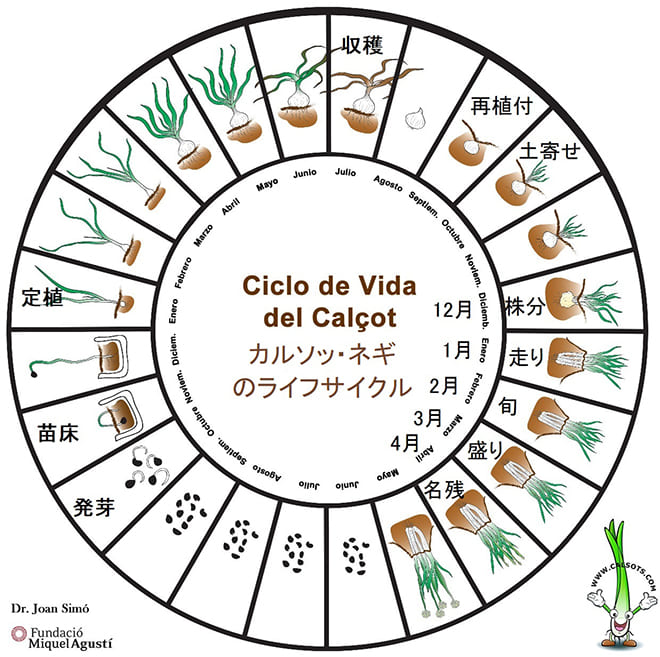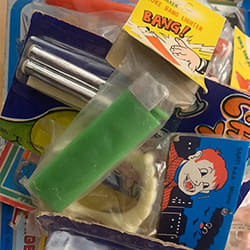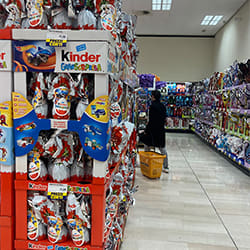
Photo 1
At first glance, it looks like a Japanese long green onion as shown in Photo 1, but it is a genuine onion grown using a special method. That method involves harvesting the onions then replanting them and during the growing process, covering the stems with soil to elongate the white part by blocking the light as they grow longer. This process is probably the same as for white asparagus and Shimonita leeks. Photo 2 shows the soil covering the stems. “Calçar” is a Catalan word meaning “cover with soil” and is the origin of the name. Figure 1 shows its lifecycle. Starting from seed collecting, it takes just about 2 years till harvest.

Photo 2

Figure 1
Long green onion barbecue festivals called calçotada are now big wintertime events held all across the 4 provinces of Catalonia, not just in the birthplace, Tarragona. Photo 3 shows how it’s done in Valls, where it originated. Calçots onions, the lead role, are barbecued until blackened over an open fire fueled by grape-vine runners, branches, and so on trimmed off after the harvest. Once barbecued, they are immediately wrapped in newspaper and left to steam for 20 to 30 minutes. They are then coated with the standard romesco sauce before eating. The province of Tarragona is also the birthplace of this sauce, which is made by mixing together almonds, hazelnuts, tomatoes, red pepper, garlic, and so on with olive oil and vinegar. Photo 4 shows romesco sauce and its ingredients. At a glance, it probably looks like a miso sauce or peanut paste.

Photo 3

Photo 4
The way you eat it is also a little unusual. It is not something you eat primly with a knife and fork. You pick up a blackened long green onion with your fingers, hold it up vertically, then pull the root end down with your other hand till the slippery white innards emerge. You coat the tender steamed white innards with romesco sauce, look up, then lower the whole thing into your mouth. This results in a terrible sight, both hands completely blackened and the front of your clothes looking as though you had just hurriedly gulped down some curry udon. That is why at trendy restaurants and the like they provide you with plastic gloves and an apron.

Photo 5
Photo 5 shows the competition at the Valls long green onion festival that has been held since 1986. Apparently the 20 competitors eat on average 200 long green onions. The record was set in 2018. It seems there was a gun eater who cleaned up 310 long green onions weighing 5.285 kg in 45 minutes. While long green onions are the main act at this calçotada party, they more or less play the role of entrée before the attendees move on to eating meat, sausages, and so on that have been roasted over the fire remaining after cooking the long green onions, which all makes for quite a heavy feast.

Photo 6

Photo 7
By the way, I discovered on the website of the Shimonita Town Tourism Association in Gunma that they have the same sort of charcoal barbecue dish using Shimonita leeks, which are grown using a similar method. They call it “Daimyo-yaki” (literally, “Lord’s Grill”). Photo 6 shows the Spanish version of the grilled long green onions and photo 7 shows the Gunma version. Just looking at these photos, no one would have any doubt which is the Catalonian long green onion dish. In Photo 8 you can see how the field where they have piled up the soil is identical to the field in Spain.

Photo 8
It is 10,373.84 km as the crow flies between Valls, Tarragona, Spain and Shimonita, Gunma, Japan. I write this report from Spain in the dead of winter with a sense of the connection between onions and long green onions/leeks and the identical methods of growing and cooking them, despite that great distance.
Incidentally, there is a calçots long green onion grill event in Fukaya, Saitama as well. Both the “Fukaya Negi Matsuri” (“Fukaya Long Green Onion Festival”) and the Gran Festa de la Calçotada de Valls were held on the same day, January 28, 2024. There is a time difference of 8 hours, however.




























































